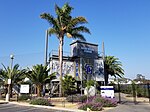North Campus Open Space

North Campus Open Space (NCOS) is a 136-acre wetland and upland restoration project (55 ha) in Goleta, California. Located on a former golf course, NCOS is managed by the Cheadle Center for Biodiversity and Ecological Restoration (CCBER), a research center under the Office of Research at the University of California, Santa Barbara (UCSB). The primary objectives of this project are: the restoration of the historic upper half of Devereux Slough and adjacent upland and wetland habitats that support important local native plant and animal species (including rare and threatened species), reducing flood risk, providing a buffer against predicted sea level rise, and contributing to carbon sequestration while also supporting public access and outreach, and facilitating research and educational opportunities for all members of the community.
Excerpt from the Wikipedia article North Campus Open Space (License: CC BY-SA 3.0, Authors, Images).North Campus Open Space
Wavecrest Court,
Geographical coordinates (GPS) Address Website Nearby Places Show on map
Geographical coordinates (GPS)
| Latitude | Longitude |
|---|---|
| N 34.419166666667 ° | E -119.8775 ° |
Address
North Campus Open Space
Wavecrest Court
93117
California, United States
Open on Google Maps








